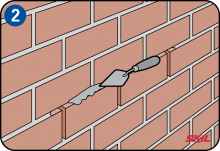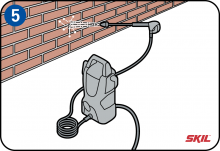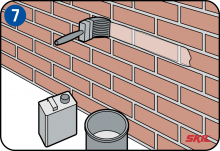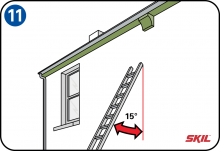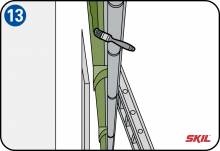-
Choosing your paint
Acrylic (water-based) wall paint is the best choice for outside walls. This kind of paint helps to make the wall waterproof, and at the same time it allows moisture that is already in the wall to evaporate to the outside. Remove as many obstacles as possible when you’re painting an outside wall, for example shutters, plants and bushes, ivy etc. Also you should check the pointing of the brickwork, and remove any plug, screws, nails etc.
-
Repairing cracks and pointing of brickwork
If you want to paint an old brick wall, there’s a good chance that some of the pointing will be cracked of has even disappeared completely. You’ll have to repair this before you can start painting. So you need to remove the damaged areas, re-point them and repair any cracks and other problems.
-
Salt deposits
If you’re painting a new wall, there’s a good chance that you’ll see salt formation and white deposits on the wall. This is because salt residues can be left behind on new walls, after the moisture in the wall has dried. You can remove this with a wire brush or with a Multi-Stripper with a cleaning brush. After that, remove the loosened powder with a soft brush. Note: don’t allow the clean and dry walls to become wet again! And don’t use a high-pressure washer, otherwise the process will start all over again.
-
Clean the wall
Always start on a clean wall. If the wall is water-sensitive, or if you live in a wooded environment, you’re sure to feel the effects of moss or algae growth. You can remove this with a wire brush and a hobby knife. Then treat the wall with bleach at a 50/50 dilution. Allow it to work for a few hours, and then rinse thoroughly with water. Make sure the wall is really dry before you start painting – this will take a few days.
-
Pressure washer
A pressure washer will allow you to remove most of the dirt from the wall. At the same time you’ll be able to remove all the loose paint and debris from the wall. If necessary you can apply moss remover – allow it to take effect and then spray the wall clean again. After that, wait 14 days before starting with the painting, depending of course on the weather.
-
Rising damp
If damp in the wall is a problem, you need to solve this problem first. The reason may be that no good insulation was applied between the foundation and the wall. In that case you can add a ventilation opening, for example in a vertical gap in the pointing, or you can replace one brick by a ventilation grid.
-
Walls with a powdery surface
Walls that have been painted earlier can be affected by powdery deposits, which will prevent good adhesion of the new paint coat. The underlying surface then needs to be fixed with a special primer. A good, firm surface is essential as otherwise the paint coat all not adhere properly, and will become loose again in just a short time.
-
Make a plinth at the base of the wall
At ground level you should brush the underside of the wall clean of soil and sand, to prevent the brush from becoming clogged. If possible, dig out to a further depth of one brick, clean out the sand and allow to dry well. First apply an undercoat to untreated bricks, and allow to dry for at least 12 hours. If you accentuate this ‘plinth’ in a darker color, splashes of mud won’t be so noticeable.
-
Mask door and window frames
Cover nearby plants and bushes with plastic foil. Mask window and door frames and other woodwork with masking tape. First paint the edges of the wall with a large brush, and paint the joints with the door and window frames and the gutters. Make sure the surfaces have plenty of overlap, and paint from the dry area to the edges of the wet paint.
Don’t be too economical with the amount of paint you use – if you don’t use enough, you may get an uneven, patchy effect.
Check the batch numbers of the paint you use. If these are different, there’s a good chance that you’ll see the differences in color, or color differences after storage for a longer period. -
Spreading the paint
Use a long-haired roller for the paintwork. Then there will be less visible overlapping, and you’ll be able to work much more quickly. Make sure the roller is well filled with paint. Apply a vertical strip of paint. Fill the roller with more paint, and apply a second strip at a distance of 40 cm. Now roll the two strips of paint diagonally over each other. Make sure you apply the paint into all the gaps and pointing. Then paint from the top to halfway down the wall, and then paint from there to the ground.
Then continue at the left or right side with the following paint strip. For smaller areas or near to door or window frames, use a narrow paint roller. Note this will always be a wet painted edge, and you should work from the dry to wet areas. -
Ladder or scaffold
Always choose a dry, wind-still day when painting. Use a good ladder or step-ladder, which should be about one meter above the working height. Make sure your ladder is standing on a stable surface, and that it is firmly supported to prevent falling.
Place the ladder at an angle of about 15° relative to the wall. Always move the ladder if you have to reach sideways by more than an arm’s length while you’re working. -
Spacer
A spacer gives the ladder extra stability and increases working safety. You can easily add a spacer to any ladder, and it is very useful for example when working on overhanging gutters. A spacer typically increases the distance between the ladder and the wall by 35 cm. For safer working, it’s best to rent scaffolding or a cherry picker.
-
Roof gutters
In many cases maintenance will also be needed for the roofing gutters and edges, and these will also need to be painted. If you’ve rented scaffolding or a cherry picker, you can also take a good look at the technical condition of the roof gutter and carry out any repairs that may be needed. See also the step-by-step instructions on ‘Maintaining rain gutters’.


